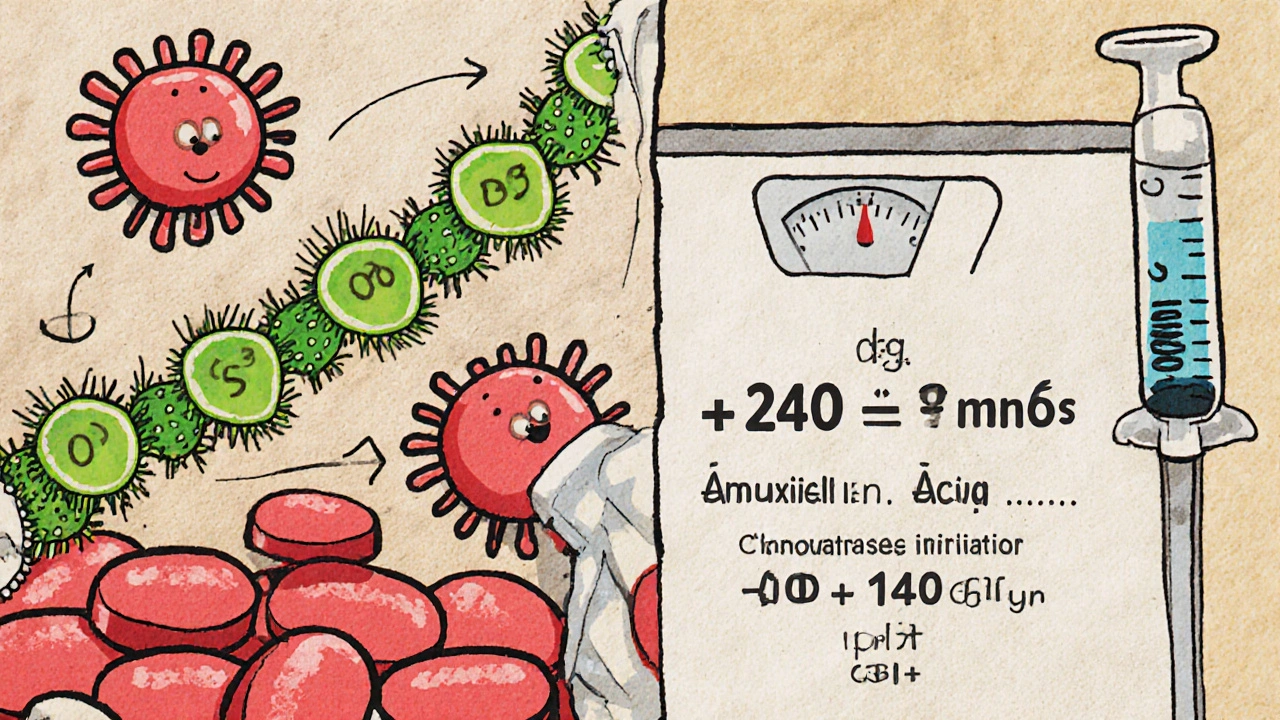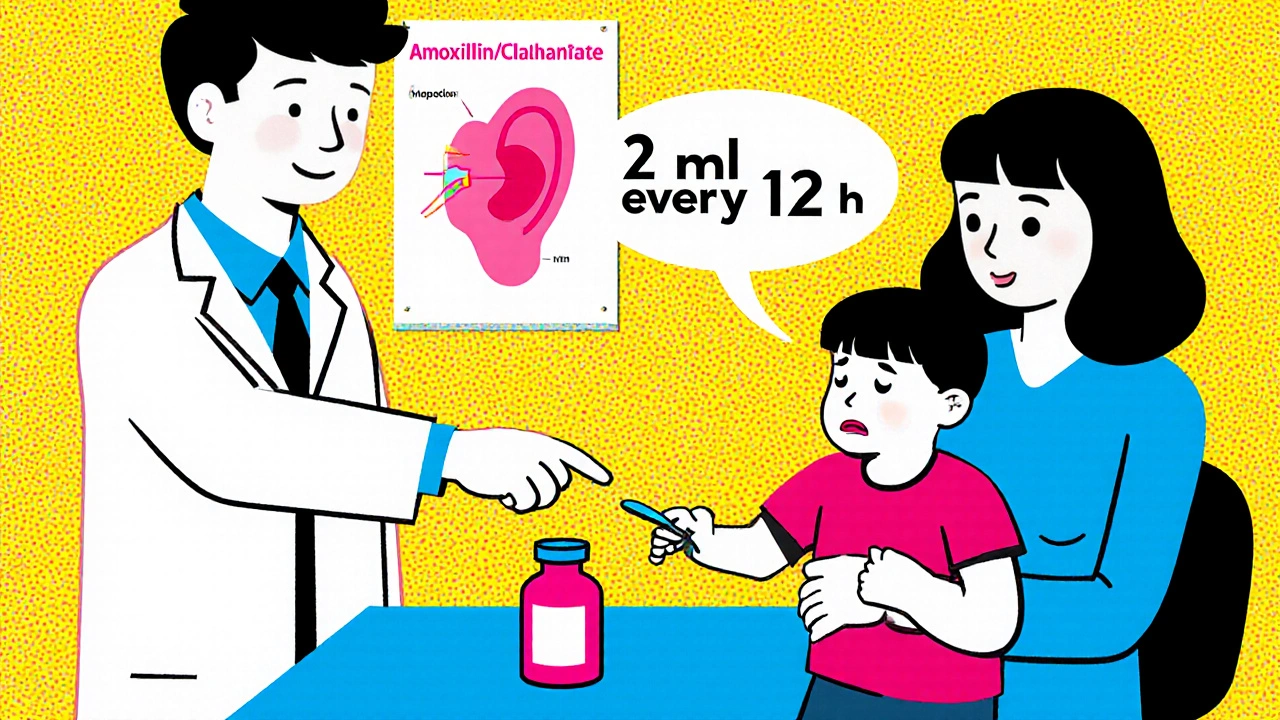Pediatric Dosing Calculator for Amoxicillin/Clavulanate
Dosing Calculator
Enter child's weight and infection type to see dosing information
Note: Doses are for children over 3 months. For infants under 3 months, consult a pediatric specialist.
When a child develops an ear infection or a stubborn cough, doctors often reach for a combo antibiotic that can outsmart resistant germs. The secret weapon in that mix is clavulanic acid, a beta‑lactamase inhibitor that revives the power of penicillin‑type drugs. This article walks you through why the compound matters for kids, how it’s dosed safely, and what side‑effects to watch for.
What Is Clavulanic Acid?
Clavulanic acid is a beta‑lactamase inhibitor that protects certain antibiotics from bacterial enzymes that would otherwise destroy them. First isolated from Streptomyces clavuligerus in the 1970s, it never works alone - it’s always paired with a beta‑lactam antibiotic, most commonly amoxicillin, to form the combination known as amoxicillin/clavulanate.
How the Combo Works: The Role of a Beta‑Lactamase Inhibitor
Many bacteria produce beta‑lactamase enzymes that cut the beta‑lactam ring of penicillins, rendering the drug useless. Beta‑lactamase inhibitor clavulanic acid binds irreversibly to these enzymes, neutralising them and allowing the partner antibiotic to reach its target
In pediatric patients, the extra protection often means a shorter illness course and fewer relapses, especially for infections that tend to hide beta‑lactamase‑producing bugs, such as:
- Acute otitis media
- Sinusitis
- Community‑acquired pneumonia
- Skin and soft‑tissue infections
Pediatric Dosing Basics
Because children aren’t just “small adults,” dosing must be calculated by weight and age. The British National Formulary (BNF) provides a clear framework:
- Determine the child’s exact weight in kilograms.
- Calculate the amoxicillin component: 20‑40 mg/kg/day divided into two doses.
- Apply the standard clavulanic acid ratio: 1 mg of clavulanic acid per 4 mg of amoxicillin (approximately 1:4).
- Round to the nearest available suspension strength (typically 125 mg/5 ml amoxicillin with 31.25 mg/5 ml clavulanic acid).
For example, a 12‑kg child with acute sinusitis would receive 240‑480 mg of amoxicillin per day, paired with 60‑120 mg of clavulanic acid, split into two doses every 12 hours.
Pediatric dosing must be adjusted for renal function in children under 3 months and for hepatic function in older kids

When to Choose Amoxicillin/Clavulanate Over Amoxicillin Alone
Not every infection needs the extra punch of a beta‑lactamase inhibitor. Overuse can increase side‑effects without added benefit. Here’s a quick rule‑of‑thumb:
- First‑line for uncomplicated otitis media or mild pneumonia: use amoxicillin alone.
- Recurrent or severe infections, especially after a recent antibiotic course, or when the child has risk factors for resistant organisms (e.g., daycare exposure), consider amoxicillin/clavulanate.
- Documented beta‑lactamase‑producing pathogens (e.g., Haemophilus influenzae with beta‑lactamase) - combo is mandatory.
Safety Profile and Common Side‑Effects
Clavulanic acid is generally well tolerated, but it does tip the side‑effect balance a bit higher than plain amoxicillin. The most frequently reported events in children are:
- Diarrhoea (up to 25% of patients)
- Rash, especially in patients with a viral prodrome
- Transient elevation of liver enzymes - usually silent, but worth checking in children with pre‑existing liver disease.
Serious adverse reactions are rare but have been documented:
- Severe hepatotoxicity (reported in <0.1% of paediatric courses)
- Clostridioides difficile colitis - a reminder to reserve the combo for cases where its benefit outweighs the risk.
Guidelines from the FDA recommend monitoring liver function if treatment exceeds 10 days or if the child has underlying hepatic disease
Practical Tips for Parents and Clinicians
- Give with food. Taking the suspension after a meal reduces GI upset.
- Measure doses with a calibrated syringe or dosing cup - household spoons are inaccurate.
- Complete the full course, even if symptoms improve in 2‑3 days, to prevent resistance.
- If diarrhea becomes watery or lasts >5 days, contact a healthcare professional; a probiotic may help.
- Store the suspension in the fridge and discard after the manufacturer’s expiry (usually 14 days once opened).
Comparison: Amoxicillin Alone vs. Amoxicillin/Clavulanate
| Feature | Amoxicillin alone | Amoxicillin/Clavulanate |
|---|---|---|
| Coverage of beta‑lactamase‑producing bugs | Limited | Broad |
| Typical pediatric dose (mg/kg/day) | 20‑40 mg/kg | 20‑40 mg/kg amoxicillin + 1‑5 mg/kg clavulanic acid |
| Common side‑effects | Rash, mild GI upset | Higher rates of diarrhoea, liver enzyme rise |
| Cost (UK, 2025) | ~£4 for 5‑day course | ~£7 for 5‑day course |
| First‑line recommendation (NICE) | Uncomplicated otitis media, mild pneumonia | Recurrent or resistant infections |
Key Takeaways
- Clavulanic acid restores the activity of amoxicillin against beta‑lactamase‑producing bacteria.
- Weight‑based dosing (1 mg clavulanic per 4 mg amoxicillin) keeps exposure low while staying effective.
- Use the combo for recurrent, severe, or documented resistant infections; avoid for simple, uncomplicated cases.
- Watch for diarrhoea and liver‑enzyme changes, especially in prolonged courses.
- Proper administration (food, accurate measuring, full course) maximises benefit and limits resistance.
Frequently Asked Questions
Can I give amoxicillin/clavulanate to a newborn?
The combination is generally not recommended for infants under 3 months unless a specialist advises it, because newborn kidneys and livers handle the drug differently. In such cases, a pediatric infectious‑disease consultant will weigh risks and benefits.
Why does my child get a rash after taking the medication?
Rash is a common immune reaction to penicillin‑type antibiotics. If the rash is mild and not accompanied by breathing trouble, most clinicians advise continuing the course. However, a widespread or blistering rash warrants immediate medical review.
Do I need to test liver function before starting the combo?
For a typical short course (5‑7 days) in a healthy child, baseline liver tests aren’t required. If treatment is prolonged, if the child has known liver disease, or if you notice yellowing of the skin or eyes, get a liver‑function panel.
Is it safe to use the suspension after the expiry date?
No. Once the suspension is opened, potency drops and bacterial contamination risk rises. Discard any leftover liquid after the labelled 14‑day period, even if it looks clear.
Can probiotics help with the diarrhoea caused by the medication?
Yes, studies in 2024 show that age‑appropriate probiotic strains (e.g., *Lactobacillus rhamnosus GG*) can shorten the duration of antibiotic‑associated diarrhoea by about two days. Give a probiotic a few hours after the antibiotic dose.

Shubhi Sahni
October 23, 2025 AT 19:42
Hey parents, caregivers, and anyone navigating pediatric infections-let's talk about why clavulanic acid matters, how it works alongside amoxicillin, and the safest way to dose it for our little ones; remember, each child is unique, so weight‑based calculations are essential, and always double‑check the measuring device-accuracy can make a big difference!
Shan Reddy
October 31, 2025 AT 07:37
I usually stick to the 1:4 ratio the article mentions; it’s a straightforward way to keep the clavulanic dose low while preserving amoxicillin’s efficacy. Just ensure you split the dose every 12 hours for consistent blood levels.
CASEY PERRY
November 7, 2025 AT 20:32
Clavulanic acid functions as a β‑lactamase irreversible inhibitor, thereby extending the spectrum of amoxicillin against β‑lactamase‑producing pathogens. Pharmacokinetic considerations dictate a dose approximation of 1 mg per 4 mg amoxicillin, calibrated to the pediatric kilogram metric. Renal clearance parameters necessitate dosage adjustments in infants younger than three months. Hepatic enzyme monitoring is advisable during prolonged regimens due to transient transaminase elevations. The synergy observed mitigates relapse rates in otitis media and sinusitis cohorts.
James Gray
November 15, 2025 AT 09:28
Cool breakdown, Casey-gonna share this with my sister who’s a pediatrician, she’ll love the clear numbers. Thanks for the solid science!
Scott Ring
November 22, 2025 AT 22:23
I’ve seen families appreciate the clear dosing tables; it reduces anxiety when you can show them the exact ml per dose on the syringe.
sara fanisha
November 30, 2025 AT 11:18
Absolutely, those visual guides make a huge difference-kids feel more comfortable when we look confident.
Tristram Torres
December 8, 2025 AT 00:14
Honestly, the article glosses over the cost barrier; many families can’t afford the £7 combo, so the “benefit” is only theoretical for them.
Jinny Shin
December 15, 2025 AT 13:09
While your point on affordability is noted, one must also consider the societal cost of untreated resistant infections-ignoring the long‑term repercussions is a tale of shortsightedness.
deepak tanwar
December 23, 2025 AT 02:05
On the contrary, the price differential is marginal when weighed against the potential reduction in hospitalization rates due to resistant organisms.